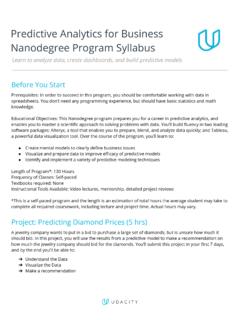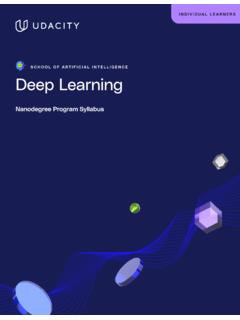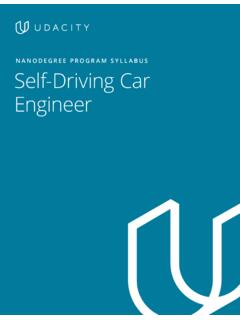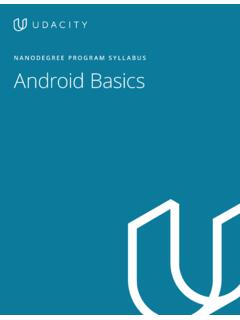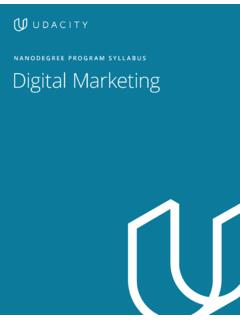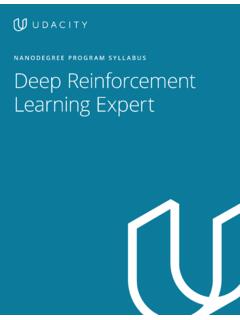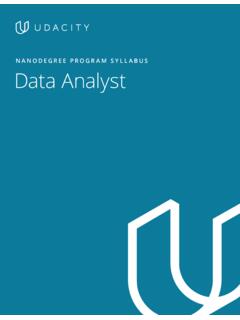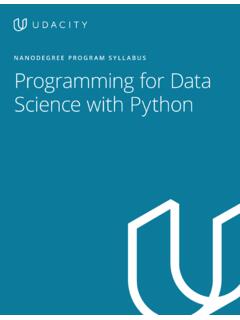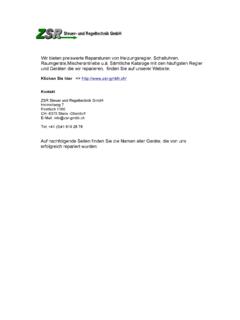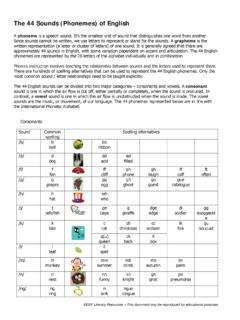Transcription of I n tr od u c ti on to Pr og r a m m i n g N a n od eg r ...
1 Introduction to Programming Nanodegree Syllabus Learn to Code Before You Start Prerequisites: No prior experience with programming is required. You will need to be comfortable with basic computer skills, such as managing files, running programs, and using a web browser to navigate the Internet. You will need to be self-driven and genuinely interested in the subject. No matter how well structured the program is, any attempt to learn programming will involve many hours of studying, practice, and experimentation. Success in this program requires meeting the deadlines set for your cohort and devoting at least 10 hours per week to your work.
2 This requires some tenacity, and it is especially difficult to do if you don't find the subject interesting or aren't willing to play around and tinker with your code so drive, curiosity, and an adventurous attitude are highly recommended! You will need to be able to communicate fluently and professionally in written and spoken English. Educational Objectives: This introductory Nanodegree program teaches the foundational skills all programmers use, whether they program mobile apps, create web pages, or analyze data. It is ideal for beginners who want to learn new skills, make informed choices about career goals, and set themselves up for success in career-track Nanodegree programs.
3 Length of Program*: 160 Hours Textbooks required: None Instructional Tools Available: Video Lectures, Practice Exercises, Student and Mentorship Community Chat, Searchable Q&A Platform *The length is an estimation of total hours the average student may take to complete all required coursework, including lecture and project time. If you spend about 10 hours per week working through the program, you should finish in 16 weeks, so approximately 4 months. Actual hours may vary. Part: Intro to HTML Estimated Time: 15 hours For this section, you will submit your very first programming file containing HTML code.
4 HTML is the coding language for building websites. We recommend taking notes from this section and using your notes as the content for your HTML file. This project is a lab that is auto-graded in the classroom. Supporting Lesson Content: Intro to the Web and HTML Basics Lesson Title Learning Outcomes Welcome to the Understanding on how to set up for the program on your personal device Nanodegree Introduction to the Programmer Mindset Successfully writing and rendering your first lines of HTML code with a text editor and browser Nanodegree Orientation Understanding on how to submit projects Understanding on student support services offered for students Habits of Successful Students The World Wide Web High level overview on how the web works Components of the web.
5 Browsers, HTTP requests, Servers, the Internet HTML Basics HTML tags Adding Images HTML Syntax Whitespace Inline vs Block elements HTML Document Structure Part: Intro to CSS Estimated Time: 25 hours In this section, you'll learn both HTML and CSS - both languages for developing websites. For the project, you'll use HTML and CSS to make Animal Trading Cards. You will apply your knowledge of HTML Document Structure to your html file and then create custom CSS styling based on your preferences. This project will demonstrate your understanding of linking CSS files in HTML files, implementing CSS classes to avoid repetition, as well create semantically organized HTML code.
6 Supporting Lesson Content: HTML Syntax & CSS Lesson Title Learning Outcomes Adding CSS to HTML Understanding CSS basics Divs, Spans, and Classes Semantic Tags Using DevTools in the Browser Verifying HTML and CSS files Debugging HTML and CSS code Page Structure Visual Styling Designing with Boxes Animal Trading Cards Apply what you've learned to create your first code-reviewed project. Part: Intro to Python Estimated Time: 70 hours In this section, you will learn the Python programming language. You will finish by building your own interactive game using Python that can be shared with your friends.
7 Supporting Lesson Content: Python Programming Lesson Title Learning Outcomes Turtles & Python Write your first lines of Python code using turtles - a visual module that displays colorful rendition of programming Functions - Part 1 Learn how to use functions to take an input and transform it into some output Explore syntax error messages and troubleshoot basic Python code Functions - Part 2 Understand the difference between print and return statements Learn how to manage the flow of a computer program using Boolean values, if statements, and While loops Shell Workshop Understand and practice working with the Command Line Interface (CLI) Python at Home Installing Python and learning Command Line Interface (CLI) basics Learn how to store values in V ariables and work with text as S.
8 Trings Selecting substrings with String Indexing Strings & Lists Learn how to store values in Variables and work with text as Strings Selecting substrings with String Indexing Use String methods: s licing , concatenation , find, and replace Use L ists to store more complex data Use f or loops to programmatically access each item within a List Version Control with Git Learn about the benefits of version control and install version control Working with Files Understand how files are created and stored in computer memory Learn how to list files in a directory, work with filenames, and move and organize files Learn how to read text from a text file, process that text using string operations.
9 And write text to another text file Work through some common bugs in text processing Objects & Classes Understand the difference between Objects and Classes in programming Define a new Class, understand the self , and defining special methods like initializers Creating instance variables Learn about inheritance, super Classes, and Class variables Part: Intro to JavaScript Estimated Time: 50 hours Learn the history of JavaScript and how it compares to Python programming. Understand how the DOM is formed, what Nodes and Elements are, and how to select items from the DOM.
10 By the end, you'll write JavaScript code that allows the user to create a grid of squares representing their design, and apply colors to those squares to create a digital masterpiece. Supporting Lesson Content: Introduction to JavaScript Lesson Title Learning Outcomes What is JavaScript? Understand the history of JavaScript and start writing your code immediately using the JavaScript console Data Types & Variables Learn to represent real-world data using JavaScript variables, and distinguish between the different data types in the language Conditionals Learn how to add logic to your JavaScript programs using conditional statements Loops Harness the power of JavaScript loops to reduce code duplication and automate repetitive tasks Functions Dive into the world of JavaScript functions.
